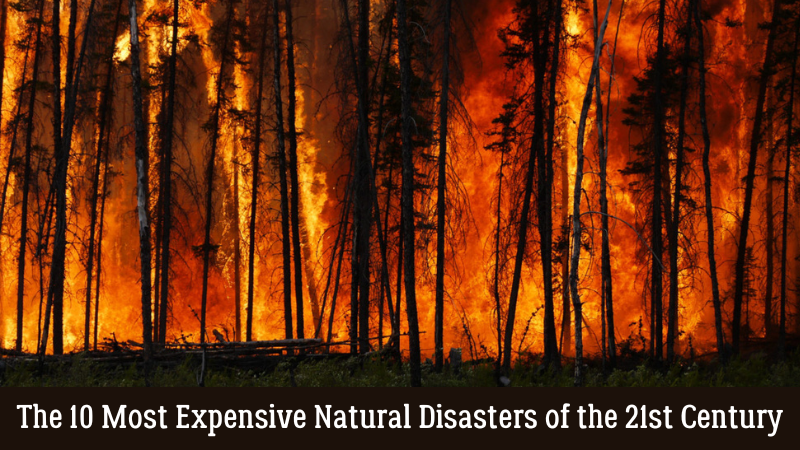The 10 Most Expensive Natural Disasters of the 21st Century

The article describes Russian fires of 2010, hurricanes Sandy and Katrina, and other natural disasters that caused multi-billion dollar damage.
Estimation of economic damage is given on the basis of data from open sources. These are direct losses from the impact of a particular element and related phenomena. That is, it is the cost of destroyed and damaged buildings, infrastructure and industry, as well as direct damage to state and personal property.
Earthquake in Japan in March 2011
Economic damage: $243.9 billion, according to the CATDAT – The Significant Earthquake Database.
The earthquake and tsunami in Japan in March 2011 can only be compared in scale with the Great Kanto Earthquake of 1923, when Tokyo and Yokohama were almost completely destroyed. In total, the disaster claimed the lives of more than 15,800 people and left more than half a million residents of Japan homeless, and the coastal territories of the eastern part of the island of Honshu were devastated.
But the catastrophe of 2011 was worse not only because of the destruction caused by the elements. The earthquake provoked an accident at the Fukushima-1 nuclear power plant. The name of the station has become as common as Chernobyl.
2008 Sichuan earthquake
Economic damage: $191.9 billion, according to The CATDAT – The Significant Earthquake Database.
The 2008 Sichuan earthquake killed more than 69,000 people, making it one of the largest earthquakes in human history. China has experienced something similar before: the 1976 Tangshan earthquake killed more than 255,000 people. In 2008, more than 4.8 million people were on the street, more than 1.5 million homes were damaged or destroyed, and economic damage exceeded $190 billion.
Hurricane Katrina 2005
Economic damage: $108 billion, according to the American National Hurricane Center.
Hurricane Katrina was one of the most devastating natural disasters in US history. More than 1.2 million homes were damaged or destroyed. New Orleans and surrounding areas were flooded. More than 1,800 people have died and more than 600,000 have been forced to leave their homes. Marauders raged in the city, and in order to restore order, the authorities even had to bring the National Guard into the city.
Hurricane Sandy 2012
Economic damage: $50 billion, according to the National Hurricane Center; $71 billion according to The New York Times.
Everyone feared that Hurricane Sandy would wreak havoc on the United States as much as Katrina had, but “it worked out.” The amount of $71 billion cannot be called small. But still, the destruction was not so massive. The hurricane affected not only the States, but also seven countries in the Caribbean region. A total of 132 people died and 305,000 houses were either destroyed or severely damaged.
2004 Indian Ocean earthquake and tsunami
Economic damage: $34 billion, according to The CATDAT – The Significant Earthquake Database.
The 2004 Indian Ocean earthquake and tsunami was a truly international disaster. It affected 15 countries and claimed the lives of more than 250 thousand people (not only local residents, but also tourists). There is still no exact data on the number of victims. Particularly affected were Indonesia (near the coast of which tremors were recorded), India, Sri Lanka, Thailand and the Maldives. The element affected mainly not very developed countries, so the economic damage was not as huge as, say, from the Japan earthquake and tsunami of 2011.
2010 Chile earthquake
Economic damage: $27.3 billion, according to The CATDAT – The Significant Earthquake Database.
Earthquakes in Chile are a fairly frequent phenomenon, but the country has not felt such strong shocks as in 2010 for several decades. Their magnitude was 8.8 on the Richter scale. A more powerful earthquake was only in 1960 – then the magnitude was 9.5 on the Richter scale. Nevertheless, the consequences were horrendous: more than 500 people died, 500,000 houses were destroyed.
Flooding in Europe in 2002
Economic damage: from €15 to €20 billion, according to the press. According to the European Commission, only Germany, the Czech Republic and Austria suffered damage in the amount of €17.4 billion.
“Flood of the century” – this is the name received in the media of a large-scale disaster that engulfed 13 European countries in the summer of 2002. As a result of rains that did not stop for a whole week, the rivers overflowed their banks: vast territories were flooded. The Czech Republic, Slovakia, Germany and Austria were particularly affected. In total, it claimed the lives of more than 230 people.
2010 Haiti earthquake
Economic damage: $7.2 billion to $13.2 billion, according to The New York Times and the Inter-American Development Bank.
After the January earthquake in 2010, the Republic of Haiti (already the poorest state in the Caribbean) became even poorer. Overnight, the country suffered economic damage comparable to its annual GDP ($11.58 billion in 2008). The capital of Haiti, Port-au-Prince, was almost completely destroyed. More than 220,000 people died, more than a million were left homeless.
Eyjafjallajökull volcano eruption in 2010
Economic damage: more than €7.3 billion, according to Spiegel magazine. According to the International Air Transport Association, the eruption alone cost airlines €1.7 billion.
Despite the fact that Eyjafjallajökull did not destroy a single house and did not kill a single person, its eruption is rightfully included in the list of the largest natural disasters of the last 13 years: after all, according to the European Commission, more than 100,000 flights were canceled, dozens of airports were closed, passengers could not fly, and airlines suffered multimillion-dollar losses every day. All this in total gave a figure of more than €5 billion.
Forest fires in Russia in 2010
Economic damage: according to official data, more than $2.8 billion.
The summer of 2010 was long remembered by the inhabitants of Russia, especially its European part: heat and drought provoked terrible forest fires. Forests on an area of more than 2.3 million hectares burned down, thick caustic smog enveloped the entire western part of Russia. More than 50 people died in the fires, 2500 houses burned down, more than 127 settlements were completely or partially destroyed. In addition, the country recorded a 17.5% increase in mortality in July-August 2010. Damage estimates varied greatly at first. And they called very astronomical sums. Thus, the director of the Wildlife Conservation Center Alexei Zimenko stated that the damage to the forest fund from fires was at least $25,000 per 1 ha of forest, or at least $375 billion in total damage.
